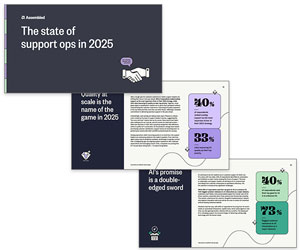Kate Hutchinson at Assembled delves into the complexities of customer support, guiding CX leaders on understanding and enhancing their team’s CX maturity to deliver exceptional customer experiences.
Providing exceptional customer support sounds simple enough: get customers the answers they need with as much speed and accuracy as possible.
Put in these terms, flying to the moon sounds easy, too: get in a rocket, aim it, and go! Share that with the scientists at NASA and you’ll get some sharp looks, at a minimum.
Just like that interplanetary journey, the reality of what it takes to provide the best customer experiences is much, much more complicated.
From balancing in-house and outsourced resources, choosing the right contact channels, and bringing AI and automation into the picture, CX leaders have their work cut out for them.
Instead of getting overwhelmed by all the moving pieces required to delight customers, CX teams should take a moment to understand where they are on their journey today. That’s where CX maturity comes into play.
What is CX Maturity?
CX maturity is a measure of the completeness and efficiency of a support function. It takes into account the people, tools, and processes currently in play in a company’s customer experience team and plots them against key benchmarks.
Basically, it’s a way to put your support function in the context of leading support functions across industries. A good CX maturity assessment will make it easy to target specific areas for improvement.
Assessing CX Maturity
To get the full picture of your team’s CX maturity, you need to break down the many aspects of support into their most granular form.
Understand the size and leadership structure of the team, take stock of tools and integrations, and document your coverage and channels. Things will probably start looking pretty complex, pretty quickly.
It’s best to start with an existing template or tool to measure your CX maturity. Be honest with yourself when taking stock of your CX function and ask the people who are hands-on with your tools and processes.
Want to know how easy it is to make real-time adjustments to schedules? Ask your real-time analysts and schedulers!
Just because it’s not something that’s on your radar to fix doesn’t mean it’s running smoothly. A CX maturity assessment is a great opportunity to check in and understand the nitty-gritty of what your team is doing.
Beware of the Tool Trap
CX maturity goes way beyond evaluating the tech stack and takes into account the people and processes you’re currently using, compared to what’s available to you.
A CX maturity assessment won’t be a recommendation of tools to buy, but it might raise your awareness of tools that could help you achieve your overall goals.
Tools must be used within the context of an optimized team structure with clear processes. The goal of a maturity assessment should be to see how you can take your team members to the next level.
After you’ve done that, you can start thinking about tools to strategically add to your tech stack. Put simply: don’t fall into the trap of thinking that just adding a new tool will solve all your CX challenges.
Stages of CX Maturity
We’ve broken down four key stages of CX maturity based on our experience working with hundreds of support teams across industries and sizes. Here’s how to think about CX maturity:
Foundation
Some teams are just getting started, and haven’t had the resources or time to intentionally create many efficiencies. At the foundation stage, CX operations have basic management practices for small teams with limited operational hours.
Processes tend to be manual, with limited tools and minimal integrations. These teams may not be using the technology they have to its fullest extent.
Growth
These teams are starting to click into gear. There’s some degree of formal management hierarchy and process optimization.
These teams may be extending operational hours past the standard local time zone 9-to-5, and may even start to add outsourced support to the mix.
They tend to be good at using their tech stack and may be implementing some of the more advanced features available to them.
Optimization
Here’s where things get really sophisticated. Customer support operations at the optimization phase have advanced management practices and complex teams across multiple regions and time zones.
They have processes and tools for comprehensive scheduling, forecasting, and performance tracking in place, including high levels of integration.
Excellence
Customer support operations in the excellence phase are highly optimized across focus areas. The organization is highly structured, offering 24×7 support with a well-managed, global team.
They excel in scheduling, forecasting, and maintaining high performance and adherence to SLAs. They use cutting-edge tools and technologies, including AI and full system integration.
What Does Full CX Maturity Look Like?
Full CX maturity means that each aspect of your support function is using all possible resources to remove the maximum amount of friction.
This optimization looks different depending on focus area. If we were to assess the maturity of a ticketing system, for example, we might go all the way from having no ticketing platform all the way up to a system that’s using all the bells and whistles of automation and customizable analytics and dashboards.
In between these two extremes, there are systems with limited features (email only, for example), standard features (adding in chat), and advanced features (multi-channel support).
Looking at the people side of things, the range would go from a handful of agents working 9-5, Monday through Friday, all the way to fully-outsourced, 24×7 operations across multiple BPO providers.
We’ll be honest with you: very, very few CX teams are leveraging all the available optimizations for their functions. The trade-offs and realities of running a business get in the way of perfection.
There are likely to be parts of the function where you’re very mature. Maybe you’ve invested in real-time monitoring to keep SLA in check.
Or it might be that you’ve doubled down on round the clock support so you’re able to successfully resolve customer cases no matter when they come in to your agents.
On the flip side, there are probably areas for improvement. Knowing where to focus will help you get the most impact from your changes.
This blog post has been re-published by kind permission of Assembled – View the Original Article
For more information about Assembled - visit the Assembled Website
Call Centre Helper is not responsible for the content of these guest blog posts. The opinions expressed in this article are those of the author, and do not necessarily reflect those of Call Centre Helper.
Author: Assembled
Reviewed by: Megan Jones
Published On: 6th Sep 2024 - Last modified: 22nd Oct 2024
Read more about - Guest Blogs, Assembled






 Assembled is a Support Operations platform that helps companies maintain exceptional customer experiences, no matter what lies ahead. Leading brands use Assembled's workforce and vendor management capabilities to make optimal staffing decisions, gain visibility into performance and productivity, and unlock new ways to serve evolving customer needs.
Assembled is a Support Operations platform that helps companies maintain exceptional customer experiences, no matter what lies ahead. Leading brands use Assembled's workforce and vendor management capabilities to make optimal staffing decisions, gain visibility into performance and productivity, and unlock new ways to serve evolving customer needs. 


































